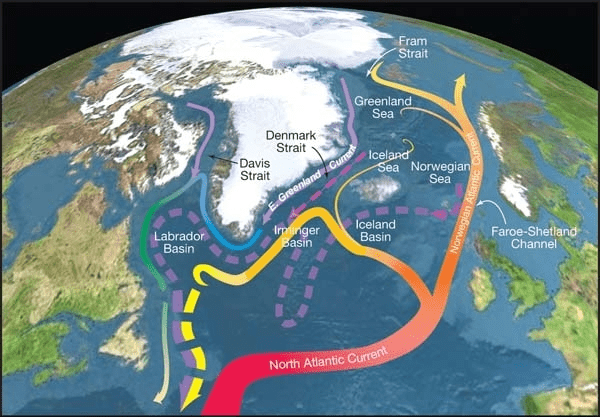
- This story is part of Covering Climate Now, a global collaboration of more than 250 news outlets to strengthen coverage of the climate story.
Warming in the tropical Indian Ocean could strengthen the Atlantic meridional overturning circulation (AMOC) system that transports warm water from the tropics into the North Atlantic, even though AMOC is expected to weaken or even halt as a result of climate change. That is the finding of a global climate simulation run by scientists in the US. They say that this is a previously unidentified link that needs to be investigated further and highlights the important role that the tropical Indian Ocean plays in global climate.
AMOC is a large system of ocean currents that transport warm water from the tropical Atlantic Ocean north towards the Arctic. The circulation is driven by differences in the water density, caused by differences in temperature and salinity. When the warm water reaches the North Atlantic it cools and its salinity increases. This now denser water then sinks and slowly moves southwards, back to the tropics, where it is warmed and the circulation continues.
The AMOC plays an important role in regulating the climate in the Europe, but recent research has suggested that it has been weakening since the mid-twentieth century. Models also indicate that this slowdown will continue as the climate warms, but there is uncertainty around the magnitude of the weakening.
Greater warming
The tropical Indian Ocean has also experienced changes linked to global warming since the mid-twentieth century, with its surface temperature increasing by more than 1 °C. This is around 50–60% greater than warming seen in other tropical basins. Due to the direct and indirect influence of the tropics on global climate, Shineng Hu, of the University of California-San Diego, and Alexey Fedorov, of Yale University, wondered if the warming of the Indian Ocean could impact global ocean circulation currents.
To test their prediction, the researchers ran a global climate model that simulated a uniform surface warming of 1 °C on the tropical Indian Ocean. This was found to strengthen the AMOC by around 30%. They also ran simulations of 2 °C of surface warming and 1 °C of surface cooling. These models suggest that the AMOC responses almost linearly to changes in Indian Ocean temperature, strengthening as it warms and weakening as it cools, they report in Nature Climate Change.
This does not mean, however, that the AMOC is getting stronger overall. Just that tropical Indian Ocean warming may have had a stabilizing effect, making the slowdown of the circulation system under climate change less pronounced, the researchers say.
Cascade of effects
Hu and Fedorov found that the mechanism behind the Indian Ocean’s impact on the AMOC involves a cascade of effects. As the tropical Indian Ocean warms, increased evaporation of its surface water leads to a rise in rainfall and an associated heat release. This influences local airflow and strengthens tropical atmospheric circulations.
As the surface ocean gets denser, the AMOC gets stronger
Shineng Hu
In the Atlantic Ocean these changes in atmospheric circulations strengthen cross-equatorial winds and lower the sea surface temperature, leading to atmospheric changes that reduce rainfall. This rainfall reduction increases surface water salinity (and hence density), and over time this more saline water is transported by the AMOC to the northern Atlantic. Once there, the denser water sinks faster than before, accelerating the deep-water convection currents. “As the surface ocean gets denser, the AMOC gets stronger,” Hu told Physics World.
Annalisa Cherchi, of the National Institute of Geophysics and Volcanology in Italy believes that the work is important because it highlights the significance of Indian Ocean warming. “It seems like it is more important in terms of climate change than was thought before,” she says. More modelling and observational work is need on the Indian Ocean, and we need to pay more attention to how it is simulated in models, she adds, “because it could be important for other processes outside the Indian Ocean”.
Hu says that it is hard to know if Indian Ocean warming will continue to stabilize the AMOC, explaining that it depends on the relative warming rates of Indian, Pacific and Atlantic Oceans. “Over the last few decades the Indian Ocean has been warming faster than the tropical Atlantic and Pacific,” he says. “That, we argue, is important for the AMOC, but if later on the Atlantic or Pacific Ocean can catch up with that warming rate then the Indian Ocean warming impact would be weaker.”
Cherchi says that while the results presented in the study seem robust, they are based on a single model, so need to be repeated with other models. Hu says that this is their next step, looking at “different climate models to see if this idea is robust across different models, and doing some diagnostic analysis to see how much tropical Indian Ocean warming has been contributing to the current AMOC changes over the past few decades”.



